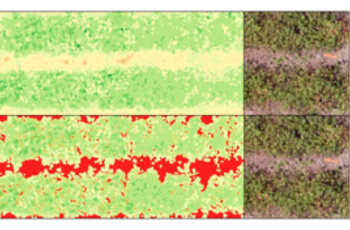Abstract
Early leaf spot (Passalora arachidicola) and late leaf spot (Nothopassalora personata) are two of the most economically important foliar fungal diseases of peanut, often requiring seven to eight fungicide applications to protect against defoliation and yield loss. Rust (Puccinia arachidis) may also cause significant defoliation depending on season and location. Sensor technologies are increasingly being utilized to objectively monitor plant disease epidemics for research and supporting integrated management decisions. This study aimed to develop an algorithm to quantify peanut disease defoliation using multispectral imagery captured by an unmanned aircraft system. The algorithm combined the Green Normalized Difference Vegetation Index and the Modified Soil-Adjusted Vegetation Index and included calibration to site-specific peak canopy growth. Beta regression was used to train a model for percent net defoliation with observed visual estimations of the variety ‘GA-06G’ (0 to 95%) as the target and imagery as the predictor (train: pseudo-R2 = 0.71, test k-fold cross-validation: R2 = 0.84 and RMSE = 4.0%). The model performed well on new data from two field trials not included in model training that compared 25 (R2 = 0.79, RMSE = 3.7%) and seven (R2 = 0.87, RMSE = 9.4%) fungicide programs. This objective method of assessing mid-to-late season disease severity can be used to assist growers with harvest decisions and researchers with reproducible assessment of field experiments. This model will be integrated into future work with proximal ground sensors for pathogen identification and early season disease detection.
Published Online: https://doi.org/10.1094/PDIS-05-23-0847-RE


